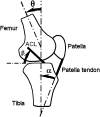Effects of a knee extension constraint brace on lower extremity movements after ACL reconstruction
- PMID: 21046300
- PMCID: PMC3094622
- DOI: 10.1007/s11999-010-1633-9
Effects of a knee extension constraint brace on lower extremity movements after ACL reconstruction
Abstract
Background: Patients have high reinjury rates after ACL reconstruction. Small knee flexion angles and large peak posterior ground reaction forces in landing tasks increase ACL loading.
Questions/purposes: We determined the effects of a knee extension constraint brace on knee flexion angle, peak posterior ground reaction force, and movement speed in functional activities of patients after ACL reconstruction.
Patients and methods: Six male and six female patients 3.5 to 6.5 months after ACL reconstruction participated in the study. Three-dimensional videographic and force plate data were collected while patients performed level walking, jogging, and stair descent wearing a knee extension constraint brace, wearing a nonconstraint brace, and not wearing a knee brace. Knee flexion angle at initial foot contact with the ground, peak posterior ground reaction force, and movement speed were compared across brace conditions and between genders.
Results: Wearing the knee extension constraint brace increased the knee flexion angle at initial foot contact for each activity when compared with the other two brace conditions. Wearing the knee extension constraint brace also decreased peak posterior ground reaction force during walking but not during jogging and stair descent.
Conclusions: Although the knee extension constraint brace did not consistently reduce the peak posterior ground reaction force in all functional activities, it consistently increased knee flexion angle and should reduce ACL loading as suggested by previous studies. These results suggest the knee extension constraint brace has potential as a rehabilitation tool to alter lower extremity movement patterns of patients after ACL reconstruction to address high reinjury rates.
Figures


Similar articles
-
Functional bracing of ACL injuries: current state and future directions.Knee Surg Sports Traumatol Arthrosc. 2014 May;22(5):1131-41. doi: 10.1007/s00167-013-2514-z. Epub 2013 Apr 27. Knee Surg Sports Traumatol Arthrosc. 2014. PMID: 23624655 Review.
-
Effects of a knee extension constraint brace on selected lower extremity motion patterns during a stop-jump task.J Appl Biomech. 2008 May;24(2):158-65. doi: 10.1123/jab.24.2.158. J Appl Biomech. 2008. PMID: 18579908
-
Effects of knee extension constraint training on knee flexion angle and peak impact ground-reaction force.Am J Sports Med. 2014 Apr;42(4):979-86. doi: 10.1177/0363546513519323. Epub 2014 Feb 14. Am J Sports Med. 2014. PMID: 24532596 Clinical Trial.
-
Anterior cruciate ligament reconstruction in adolescent patients: limb asymmetry and functional knee bracing.Am J Sports Med. 2012 Dec;40(12):2756-63. doi: 10.1177/0363546512460837. Epub 2012 Oct 3. Am J Sports Med. 2012. PMID: 23035150
-
The effect of bracing on proprioception of knees with anterior cruciate ligament injury.J Orthop Sports Phys Ther. 2002 Jan;32(1):11-5. doi: 10.2519/jospt.2002.32.1.11. J Orthop Sports Phys Ther. 2002. PMID: 11787904 Review.
Cited by
-
Innovative rehabilitative bracing with applied resistance improves walking pattern recovery in the early stages of rehabilitation after ACL reconstruction: a preliminary investigation.BMC Musculoskelet Disord. 2020 Oct 2;21(1):644. doi: 10.1186/s12891-020-03661-z. BMC Musculoskelet Disord. 2020. PMID: 33008346 Free PMC article.
-
Functional bracing of ACL injuries: current state and future directions.Knee Surg Sports Traumatol Arthrosc. 2014 May;22(5):1131-41. doi: 10.1007/s00167-013-2514-z. Epub 2013 Apr 27. Knee Surg Sports Traumatol Arthrosc. 2014. PMID: 23624655 Review.
-
Physical Performance Improves With Time and a Functional Knee Brace in Athletes After ACL Reconstruction.Orthop J Sports Med. 2020 Aug 12;8(8):2325967120944255. doi: 10.1177/2325967120944255. eCollection 2020 Aug. Orthop J Sports Med. 2020. PMID: 32851108 Free PMC article.
-
Brace-Free Rehabilitation after Isolated Anterior Cruciate Ligament Reconstruction with Hamstring Tendon Autograft Is Not Inferior to Brace-Based Rehabilitation-A Randomised Controlled Trial.J Clin Med. 2023 Mar 6;12(5):2074. doi: 10.3390/jcm12052074. J Clin Med. 2023. PMID: 36902868 Free PMC article.
-
Does the hyperextension maneuver prevent knee extension loss after arthroscopic anterior cruciate ligament reconstruction?J Orthop Traumatol. 2016 Dec;17(4):327-331. doi: 10.1007/s10195-016-0408-9. Epub 2016 May 10. J Orthop Traumatol. 2016. PMID: 27164977 Free PMC article. Clinical Trial.
References
-
- Beynnon BD, Uh BS, Johnson RJ, Abate JA, Nichols CE, Fleming BC, Poole AR, Roos H. Rehabilitation after anterior cruciate ligament reconstruction: a prospective, randomized, double-blind comparison of programs administered over 2 different time intervals. Am J Sports Med. 2005;33:347–359. doi: 10.1177/0363546504268406. - DOI - PubMed
Publication types
MeSH terms
LinkOut - more resources
Full Text Sources
Medical

